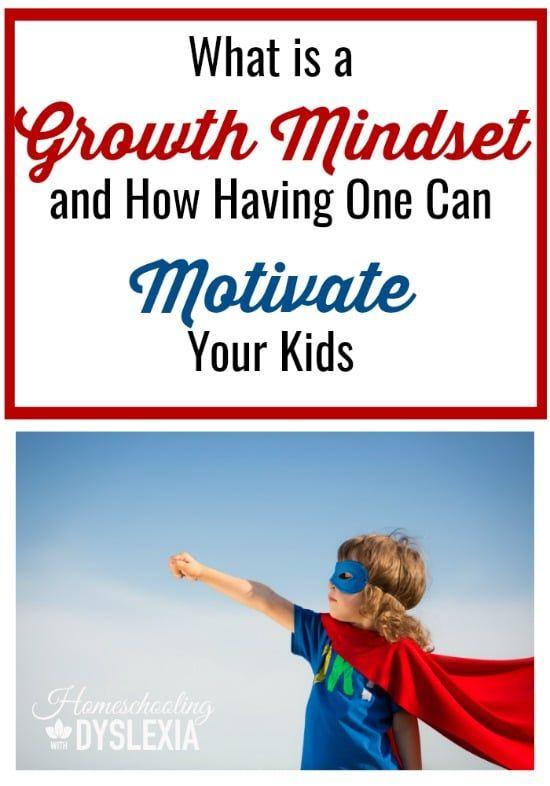If you have kids who shut down when learning gets hard, read this post on how teaching kids to have a growth mindset can motivate them to press through those difficulties.
If you would prefer to listen to this post, click the player below:
If you’ve been around the Homeschooling With Dyslexia web site or Facebook page for long, you know how I love to learn about learning. Since I learn completely differently than 7 of the 8 kids that I homeschool, you could say it is a bit of a necessity. Good thing I have learned to enjoy it!
Today I am going to share with you about some fascinating research that was done at Stanford University here in California by Carol Dweck. Carol and her team were studying the idea of learned helplessness in lab animals and began to apply their knowledge to the same sorts of attitudes in people. This research led them to learn about the profound effect of a person’s mindset, or attitude about learning, could have on motivation and academic performance.
Two Kinds of Mindset
In her research, Dr. Dweck identified two types of mindsets; the fixed mindset and the growth mindset.
Fixed Mindset: This is the belief that intelligence is fixed and that any subject that is difficult or requires much effort simply means that you are dumb.
Growth Mindset: This is the belief that intelligence can be grown and that subjects that are difficult or require extra effort mean that you are increasing your intelligence.
Let’s look at some of the research done at Stanford to illustrate this concept a bit better.
Dweck took a group of incoming 7th graders and divided them into two groups based on an evaluation of their mindset – the fixed mindset and the growth mindset groups.
Both groups of kids were working at the same level academically at the beginning of 7th grade, but by the end of the first term their grades were clearly split with the growth mindset group significantly out performing their fixed group counterparts. This trend continued steadily over the next two years. Interesting, huh?
Here are a few more observations of these two distinctly different kinds of mindsets:
The fixed mindset group:
- only cared about looking smart
- didn’t want to take the risk of looking dumb
- were determined to ‘look smart’ at any cost whether that meant lying or cheating to achieve the goal
- avoided academic challenges
- felt learning should come easily and that if they needed to apply much effort that they were not smart
Because of these beliefs, students with a fixed mindset had no real way to handle learning difficulties so were quick to give up or become defensive – either acting bored, acting out, blaming the teacher or the material to hide their fear of not looking smart.
The growth mindset group:
- were not afraid to work hard
- understood that learning takes practice and that even geniuses have had to work hard for their discoveries
- understood that hard work and practice make you smarter
Because of these beliefs, students with a growth mindset learned how to capitalize on their mistakes and look at set backs as a natural part of learning.
Thomas Edison had a growth mindset.
I am not discouraged, because every wrong attempt discarded is another step forward.
– Thomas Edison
How Do We Get Our Mindset?
Simply stated, we develop our mindset based on the kinds of praise we receive with regards to our efforts. Research done at the height of the self esteem movement found that this constant praise of ability was back firing.
Let’s look at another bit of research to better understand this point.
Kids were given a fairly simple non-verbal IQ test. The 3 groups received a different response towards their work:
Praise for their intelligence: the first group was praised for their intelligence. “You did a great job! You must be smart.”
Praise for their process: the second group was praised for their effort. “You did a great job! You must have tried very hard.”
The control group: this group received a neutral response. “You did a great job!”
Next, these groups were offered an opportunity to choose the level of difficulty of their next task. Fascinatingly, kids who were praised for their intelligence, chose an easy task while those who were praised for their effort chose the harder task.
It was concluded that both groups of kids were sensitive to what the researchers valued – effort or intelligence – and were motivated to continue to score well in those areas.
The Powerful Effect of Praise
Recent studies have shown that the ways a mother praises her baby predicted that child’s mindset 5 years later. The development of mindset – whether fixed or growth – starts young. The good news is, however, that everyone’s mindset can be changed.
One Simple Word
By changing our language and being particular about which words we use, we can begin to change the mindsets of our kids and ourselves.
In one school, instead of giving a non-passing grade to students, they were given two words – NOT YET. Think about what this implies.
A ‘D’ or ‘F’ means that you are nowhere, but a “Not Yet’ means that you are on your way.
Try adding the word ‘yet’ on to these negative responses common within the fixed mindset.
If a student says:
“I’m not good at ______.”
“I can’t do _________.”
“I tried but it didn’t work.”
Add yet to the end of the sentence.
The Transforming Power of Teaching a Growth Mindset to Students
Researchers took a group of 7th graders, all with a fixed mindset and divided them into 2 groups.
Group 1 received 8 sessions of study skill instruction as well as growth mindset instruction. They were taught how to study and also taught how every time their brains worked hard, more neurons formed in their brains and that over time, they would become smarter.
Group 2 received only the 8 sessions of study skill instruction.
The results were significant. Group 1 scored dramatically better on their coursework during the following year than Group 2. A mindset can be changed!
Fixed and Growth Mindsets
There is a ton of research being done on the power of a person’s mindset showing that a person’s attitude towards their ability to learn is an incredibly powerful indicator of how that person will perform academically, and this attitude, or mindset, can be changed!
This can be especially profound for the student who struggles to learn because of dyslexia, dysgraphia, dyscalculia or ADD. I know that there are kids in our family, the ones with more natural academic ability interestingly, that struggle with a fixed mindset.
How have you seen this mindset play out in your family?
Join me tomorrow for a look at How to Teach a Growth Mindset.

Growth Mindset Resources
Big Life Journal Known for their best-selling journals for kids and teens as well as beautifully illustrated worksheets and motivational printables.
Mindset by Carol Dweck. Read from the researcher herself about the strategies used to study the amazing impact of a growth mindset on students.





This is such a great reminder, especially as I pray for the coming year’s focus, goals, etc… It’s so easy for me to get swept up in what the system wants, are they testing properly, even after 12 years of homeschooling! I spent way too much of that time comparing and beating myself up. Your articles have been so encouraging in focusing on the strengths of dyslexia, and today’s topic of mindset was perfect timing. Now to begin praying about my own mindset, first…
Thanks, Marianne!
the pod cast was pretty good
Thank you for this article! I have been wondering for a while how praise ties into the self-esteem/view of self as far as learning is concerned. My daughter attended public school for K and 1st and had developed the “Fixed Mindset” and very low self-esteem. No matter how much I praised her efforts at home or encouraged her to keep trying, the 6+ hours in school convinced her that she was “too dumb” and she couldn’t do it.
I had her evaluated for a possible learning disorder and she was diagnosed with ADD, Dyslexia, Dysgraphia, and some Sensory Processing Disorders. That’s when I pulled her out of public school and started homeschooling her. It broke my heart to see my little “Flower Girl” so discouraged.
We are just about to finish our second year of homeschooling now and she seems to be back to her old self. My daughter is more confident even though she still struggles with reading and writing. She was upset that she got ONE problem wrong on her Math test and not 100%! ☺️
We are still working on getting rid of test anxiety and different strategies to solve problems. I believe that her mindset it slowly changing into growth orientation and I can’t wait to read your next article on this subject.
Excellent! I thoroughly enjoyed reading this article. I am looking forward to reading the following article(s).
More proof that the brain/mind is malleable and doesn’t have to get “stuck” in a “negative zone”. Therefore you can teach an old human…I mean old dog new tricks. 😉
Thank you so much for this valuable information. At Gemm Learning, we service children and adults with a variety of challenges; dyslexia, dysgraphia, dyscalculia, ADD, CAPD, etc. A huge part of what we do at Gemm is offer continuous support to families to help motivation. The students (and parents) that use our program often need “pep talks”. I will definitely share this and subscribe to your page.
Great article! For all the homeschool teachers out there, there’s an excellent free lesson designed to get your students understanding, practicing and using growth mindset. Find it at: https://www.teacherspayteachers.com/Product/FREE-Introduction-to-Growth-Mindset-Lesson-Pack-3366121